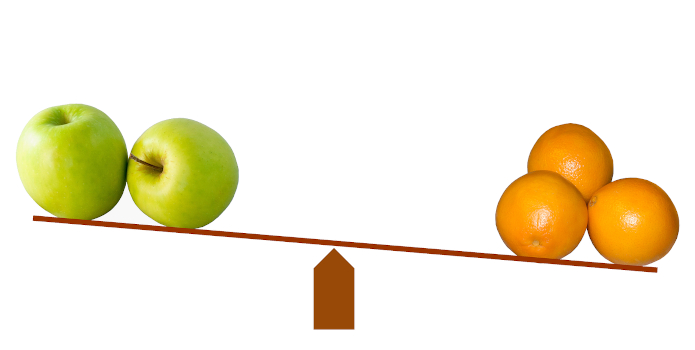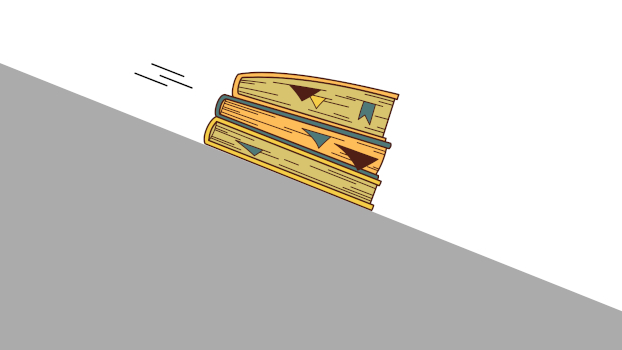
An unbalanced force is a force that causes a change in the motion of an object.[1][2] It occurs when the forces acting on an object are not balanced and do not cancel each other out. As a result, the object is not in a state of equilibrium and will experience acceleration.[3]
Examples
Seesaw in motion

A seesaw provides a clear example of an unbalanced force in action. Imagine a seesaw with two individuals of different weights sitting on each end. Since their weights are unequal, there is an imbalance of forces on the seesaw. The side with the heavier person exerts a stronger downward force, causing that end to lower while the other end rises. This movement occurs because the forces acting on the seesaw are unequal, resulting in an unbalanced force. The seesaw continues to tilt until the forces become balanced or until another force comes into play. This unbalanced force is responsible for the dynamic motion observed on a seesaw.
Sliding book

When a book is placed on a slanted surface, it tends to slide downwards. This sliding motion occurs because of an unbalanced force acting on the book. Normally, when a book rests on a flat surface, the forces acting on it are balanced, with an equal upward force countering the downward force of gravity. However, on a slanted surface, the forces are no longer equal. The force pulling the book downwards becomes stronger than the upward force, causing the book to slide. This difference in force magnitudes creates an unbalanced force that initiates the sliding motion. So, when a book is placed on a slanted surface and starts sliding downwards, it’s an indication of an unbalanced force at play.
Moving wooden block

When a wooden block is pushed with force, it moves forward, indicating the presence of an unbalanced force. Initially, the wooden block is in a state of balance with equal upward and downward forces, keeping it stationary. However, when an external force is applied to the block, it undergoes slight forward movement, signifying the existence of an unbalanced force.
Kicked football

When a football is kicked with the leg, it experiences an unbalanced force that propels it into motion.[4] The act of kicking imparts an external force on the football, disrupting its state of rest and initiating its movement. This unbalanced force is responsible for the change in the football’s motion, allowing it to travel in the direction of the kick.
Snowmobile in motion

When a snowmobile is pushed or pulled by hand, it demonstrates unbalanced force. Unbalanced forces occur when the net force acting on an object is not zero, causing it to accelerate or change its motion. In this case, the applied force by the person creates an unbalanced force on the snowmobile. If the applied force is greater than the opposing forces like friction and air resistance, the snowmobile accelerates. Conversely, if the opposing forces are greater, the snowmobile decelerates or comes to a stop.
Accelerating car

When a car starts and accelerates forward, it experiences an unbalanced force.[5] Prior to starting, a car is in a state of balance, with upward and downward forces balancing each other. However, when the car is started, the engine exerts a force that propels the car forward, causing it to accelerate. This force, which enables the car to accelerate, can indeed be referred to as an unbalanced force.
Related
- Force examples
- Normal force examples
- Balanced force examples
- Unbalanced force examples
- Applied force examples
- Compression force examples
References
- What Happens When Forces Are Balanced or Unbalanced? – Woodstown-Pilesgrove Regional School District
- Forces and interactions – NYU Tandon School of Engineering
- the unbalanced force – University of Alaska Fairbanks
- Newton’s First Law – CK-12 Foundation
- forces and motion the downhill racer – The University of Akron
External links
- Unbalanced Force: Definition & Example – Study.com
- Balanced vs. Unbalanced Forces – The Physics Classroom
- Motion: Balanced and Unbalanced Forces – Turito
- Balanced & Unbalanced Forces Video For Kids – Generation Genius
- Examples of unbalanced forces with explanation – PhysicsGoEasy
- Unbalanced forces and motion (video) – Khan Academy
- An example of balanced and unbalanced forces – IOP Spark
- What are some examples of unbalanced forces? – Quora
- Balanced and Unbalanced Forces – BBC
- What is a Unbalanced Force? – Sciencing
- Balanced & Unbalanced Forces Examples and Vocabulary Review – Quizlet
Deep
Learnool.com was founded by Deep Rana, who is a mechanical engineer by profession and a blogger by passion. He has a good conceptual knowledge on different educational topics and he provides the same on this website. He loves to learn something new everyday and believes that the best utilization of free time is developing a new skill.
